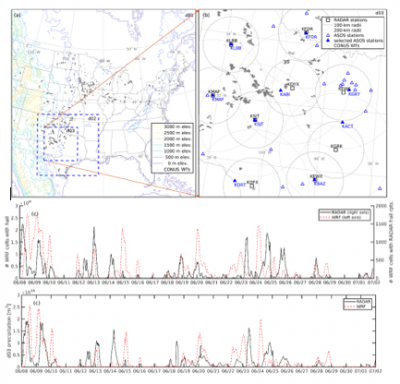WRF Modelling of Deep Convection
Deep convection and the related occurrence of hail, intense precipitation, and wind gusts represent an important atmospheric hazard. According to the Insurance Institute for Business & Home Safety hail resulted in over $10 billion of losses in Texas during 1999-2011. Thus there is a need to evaluate the degree to which atmospheric models are capable of reproducing organized deep convection in the contemporary and possible future climate. Here a 25-day simulation with the Weather Research and Forecasting (WRF) model over the Southern Great Plains (SGP) is performed and evaluated. The simulations cover June-July 2014 and use triple nesting; 12-4-1.33 km and thus the two inner domains are at convection-permitting resolutions. The output is evaluated using RADAR observations of precipitation (including hail) and reflectivity plus in situ wind speed measurements and wind power generation. Hail events frequently occur during periods when wind turbines are rotating and are especially important to damage to wind turbines and other energy infrastructure in SGP. The presence of hail is modeled with a mean proportion correct of 0.77 and an odds ratio of 4.55.
The cost of electricity from wind turbines has halved over the last 12 years to levels where it is the most cost-efficient of any renewable generation source. Accordingly, wind energy is already making a substantial contribution to the decarbonization of the energy system and is poised to make a greater contribution. However, it is imperative to continue to develop and advance technologies to more efficiently and cost-effectively capture ‘the power of the wind’ and to ensure the reliability of this electricity generation source. One mechanism to achieve this is to enhance the durability of wind turbine blades. Leading-edge erosion (LEE) is the primary cause of reduced blade lifetimes and is the focus of our research. LEE is the result of material stresses caused by the impact of falling hydrometeors (rain droplets and hailstones, falling at up to 10 m/s) on rapidly moving wind turbine blades (tip speeds are up to 90 m/s). In each of these collisions, energy is transferred into the blades resulting in materials stresses and fatigue. Over time, or in extreme events individual impacts, stresses exceed the material strength causing the blade coating to crack, resulting in loss of blade material. This material loss changes the shape of the wind turbine blade and reduces both aerodynamic lift and electricity production. This problem is decreasing the reliability of wind energy and costing the wind energy industry via lost revenues because the wind turbine blades have to be removed and repaired or replaced. This work seeks to address if the WRF model could be used to this work develop a priori estimates of LEE potential in a given location that could help wind farm developers make informed decisions regarding the costs and benefits of adding additional leading-edge protection. The rate of LEE is a function of:
- Wind speed, via its control on wind turbine blade rotational speed, the closing velocity between the blade and the hydrometer, and thus the kinetic energy transfer
- Precipitation rate that controls the number of impacts and kinetic energy transfer
- Hydrometeor type that controls the material response
- Hydrometeor diameter that controls the fall velocity, momentum exchange & material response
Thus, there is a need to demonstrate fidelity for the marginal and joint probabilities of these properties.
This research demonstrates that WRF exhibits some skill in representing the primary drivers of wind turbine blade LEE. Wind speeds, rainfall rates, and precipitation totals show good agreement with observations. The occurrence of precipitation during power-producing wind speeds is also shown to exhibit fidelity. Hail events frequently occur during periods when wind turbines are rotating and are especially important to LEE in the SGP. The presence of hail is modeled with a mean proportion correct of 0.77 and an odds ratio of 4.55. Further research is needed to demonstrate sufficient model performance to be actionable for the wind energy industry, but this work illustrates the potential to address this important industry need.

